Tunic
This man’s tunic, likely woven on the coast of what is now northern Chile, in a region dominated by the Inca Empire, is an elegant riff on a classic Inca-style garment (see, for example, accession number 2017.674). Here, the checkerboard pattern has been modified into two rows of large rectangles in red and purple using cochineal as a dying agent. The horizontal band with a yellow and white zigzag on the upper part of the tunic is also reminiscent of classic Inca tunic design. Woven with camelid fiber--typical of highland Inca garments—the tapered shape and feather adornments alongside the neck slit are more local in flavor.
Although indigo was used in Peru to create blue and purple, chemical analysis of this textile revealed that the purple/blue areas contain only cochineal (Phipps, 2015). Thus, the weavers modified the normally bright red of the dye to another hue probably through the use of special mordants, the material used to fix the dye to the thread. However, indigo was used in the green vertical stripes along the sides by combining indigo and a yellow dye. Phipps (2015) has suggested that this may represent an attempt to use the more available cochineal and conserve the rarer indigo.
References and Further Reading
Correa-Lau, Jacqueline, Carolina Agüero, Jeffrey Splitstoser, Ester Echenique, Tracy Martens, Calogero M. Santoro, "Inka Unku: Imperial or provincial? State-local relations." PLoS ONE 18(2): e0280511. (2023).
Phipps, Elena. "Shades of Red: Color and Culture in Andean Textiles." In A Red Like No Other; How Cochineal Colored the World, edited by Carmella Padilla and Barbara Anderson, p. 112, pl. 14.8. New York, NY: Skira/Rizzoli, 2015.
Phipps, Elena. Cochineal Red: The Art History of a Color. New York: The Metropolitan Museum of Art; New Haven, CN: Yale University Press, 2010, pp. 23-24, Fig. 41.
Phipps, Elena. "Rasgos de nobleza: Los uncus virreinales y sus modelos incaicos." In Los Incas, Reyes del Perú, edited by Tom Cummins, Gabriela Ramos, and Elena Phipps, pp. 68-93. Lima, Peru: Banco de Crédito, 2005.
Phipps, Elena, "Garment Traditions of the Andes: Construction, Gender and Identity." In Inca: Textiles and Ornaments of the Andes, edited by Serge Lemaitre, pp. 97. Brussels, Belgium: Ludion, 2018.
Pillsbury, Joanne. "Inka Unku: Strategy and Design in Colonial Peru." Cleveland Studies in the History of Art 7 (2002):68-103.
Pillsbury, Joanne. "El uncu Inca: Tradición y transformación," in Arte imperial Inca: Sus orígenes y transformaciones desde la conquista a la independencia (edited by Ramón Mujica), pp. 274-311. Lima: Banco de Crédito, 2020.
Rowe, Ann Pollard. "Technical Features of Inca Tapestry Tunics," Textile Museum Journal 17 (1978), pp. 5-28.
Rowe, Ann Pollard. "Provincial Inca Tunics of the South Coast of Peru," Textile Museum Journal 31 (1992), pp. 5-52.
Rowe, Anne Pollard, and John Howland Rowe. "Inca Tunics." In Andean Art at Dumbarton Oaks Vol. 2, edited by Elizabeth Hill Boone, pp. 453-465. Washington, DC: Dumbarton Oaks Research Library and Collection, 1996.
Rowe, John Howland. "Standardization in Inca Tapestry Tunics." In The Junius B. Bird Pre-Columbian Textile Conference, May 19th and 20th, 1973, edited by Ann Pollard Rowe, Elizabeth P. Benson, and Anne-Louise Schaffer, pp. 239-264. Washington, D.C.: The Textile Museum, 1979.
Due to rights restrictions, this image cannot be enlarged, viewed at full screen, or downloaded.
This artwork is meant to be viewed from right to left. Scroll left to view more.







